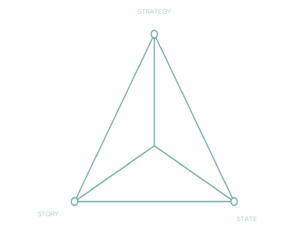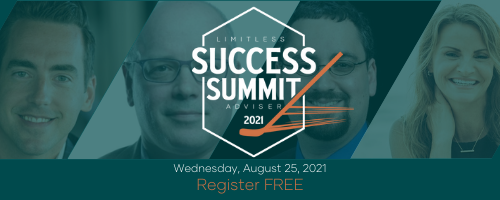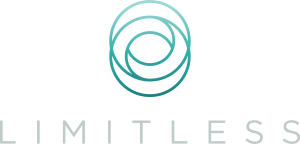If you’re completely content with your revenue, income, growth rate, service levels, team performance, business operations, daily workload, time off and the way you feel taking it, you’ve clicked on the wrong article. This is for advisors who are ready to unleash their inner game-changer and create hockey-stick-like growth.
Every day, I have conversations with advisors and leaders who are creating new levels of success for themselves and their firms. Over the years, I’ve noticed a trend among them that I want to share with you. But first, let me pose a riddle.
There are five frogs sitting on a lily pad. One decides to jump off How many frogs are left on the lily pad?
Chances are, your math skills led you to answer ‘four.’ But this isn’t a math question. It’s a life problem.
The correct answer is ‘five’ frogs. All five frogs are still sitting on the lily pad because, like most people, the frog made a decision–probably a great decision–but at least so far, it’s still stuck sitting on the lily pad.
Breaking the Uncomfortable Habit of Being Under-Successful
The frog in this riddle is in the habit of sitting uncomfortably – but sitting nonetheless – on the lily pad. The advisors and leaders who are able to break through to the next level of success have lily pads like everyone else, they just don’t get stuck sitting on them for so long they forget what it takes to make that next big leap in their business. In practice, though, the frog-like far too many advisors – is stuck in the comfortable habit of being under-successful.
The cost of this under-performance shows up when evaluating research on advisor pay, work-life balance, and overall happiness.
By one measure, Kitces Research tells us that the most successful advisors leading teams are taking home $460,000 a year more in compensation than most of their peers. Standout solo advisors (the top 10%) with a support team net over $660,000 in take-home profits, while the median solo practitioner takes home just $$200,000 in total compensation.
Contrast this with some of the advisors I’ve coached featured on the Financial Advisor Success podcast, Tanya realized she could 2x her income, cut her hours in half, and “take Fridays off laughing with her kids”. Ben grew from $38 million to $100 million AUM working less than 30 hours a week, hit 60% profitability, and takes 80 days off a year to spend with his six kids. Adam grew his firm 3x and generated a steady waiting list of HNW clients while getting his pilot’s license–and still has time to help other advisors get hyper-efficient. Taylor differentiated his digital marketing to generate 15 HNW prospects a week, grow to 7-figure AUM and he spends his free time supporting his peers with Advisor Growth Community.
The data tells us that these examples are the exceptions, not the norm. But is that because it’s not achievable for most? Or simply because far too many advisors–small and large–know that they’re underperforming their potential, and have some idea what to do about it… but they’re still sitting on the lily pad?
With that in mind, let’s have a conversation about why we get stuck in the uncomfortable habit of being under-successful, and how you can unleash your inner game changer to create hockey-stick-like growth.
Getting Different Results Requires Different Thinking
There is no shortage of reasons to remain stuck on the lily pad. But when we’re brutally honest with ourselves, few of these reasons hold up under serious scrutiny.
These other advisors were able to produce such radical results only after they learned the first and best step to unleashing their inner game-changer: they learned to think differently.
Which then led them to map out their model practices, implement model schedules and client meeting surges, and set about creating specialized service systems to deliver deeper value with ultra-efficiency. They re-defined their brands, committed to clients and growth channels, and systematized their business systems to leverage their time, talent and teams to the utmost.
And while implementing such systems does take work, including perhaps additional learning about what to do and how to implement, the point remains that reaching the next level of success isn’t really about the methods, per se. Anyone can implement the methods. But not everyone takes the leap off the lily pad to do so.
The Science Of Stepping Up Our Success
A Cambridge Institue of Technology study shows that our success is primarily driven by three key factors: environment, skill, and psychology (mindset). The staggering part of the conclusions is that success is considered to be 85% mindset, and only 15% methods.
If success is 85% mindset, it is evident that, no matter how much energy and effort we focus on methods, our mindset is more than capable of preventing us from breaking those habits that keep us sitting on the lily pad.
It was after we both spoke at a conference three years ago that Michael and I sat down in two overstuffed chairs at the edge of an empty conference hall and talked about how mastering my mindset helped me accelerate my and my clients’ success and well-being in profound ways. And so began the conversation that began our coaching relationship.

I want to be abundantly clear that I’m not taking credit for Michael’s success, or any of my clients’, for that matter. They earned their results the good old-fashioned way; they did the work. But when I or any coach help people elevate their thinking about what’s possible, a catalyst effect really can occur.
This January, Michael sent me an email sharing what I’ve dubbed his ‘hockey-stick-style growth chart,’ reflecting growth since we started working together.
The key, though, is to recognize that even a trend of years of limited or stagnant growth – as was the case with Michael in the chart above – can experience a breakthrough in growth when we have a change in mindset. Change is always possible…but we must do more than decide we’re ready, we must take the leaps to make it happen.
Our Brains Stacks The Deck Against Us
It’s not your fault that the lily pad is still under your feet. You’re playing against a stacked deck.
Imagine if I asked you to reach your grandest goals, but with a catch: you had to undertake the challenge using only 5% of your resources. You’d undoubtedly expect greater struggle and slower going than if you had full access.
In 2005, the National Science Foundation summarized research showing that we have an average of 12,000 to 60,000 thoughts per day. Of those thoughts, 80% are negative, and 95% are on the same repetitive replay loop as the day before. Further research shows that 95% of our decisions are made by our unconscious minds, up to seven seconds before we’re consciously aware of the decision having been made.
Which means you came to work today with the deck stacked 95% in favor of today being like all the days before it, because you’re only in charge of your most valuable resource – your thinking – 5% of the time.
Letting go of our conditioned states of thinking creates a catalyst affect vis-à-vis the new decisions we make and more aligned actions we take.
When Einstein said that “no problem can be solved with the same consciousness that created it” he referenced the fact that it’s the tendency for our thinking to run in stagnant circles that keeps us stuck.
Solving For X With The Success-Stack
If you’re ready to set the stage for serious growth, you can use my simple “Success Stack” exercise to get clear on what’s been holding you back.
The triangle below represents the relationship between the three realms in which we’re continuously co-operating and co-existing: state (the way we feel), stories (the dialogue we’re having with ourselves), and strategies (the actions we take when we apply energy to ideas).

Stories are the belief systems that largely auto-govern our thoughts. State is our physical being, reflecting how we feel. Strategy represents the actions we take to deliver certain outcomes.
If you want to elevate your thinking, feeling and actions in any situation, you can rely on the success-stack, and a few simple questions, to reset your compass and restart your growth.
Our Stories Are What Make Us Stuck
Our brains take in 11 million bits of information a second, but can only consciously process 40bps, leaving the rest of the work to happen behind the veil of our consciousness. We have primitive survival systems that ensure that we eat, breathe, and run when necessary. In the space between these primitive systems and our conscious thoughts is our unconscious, which is governed by our internal representations of reality, or belief systems.
For a simple example of a belief system, think of a time when a prospect asked you for a discount. What was your immediate response? Most advisors instinctively offer to reduce their fees to ensure they get the client.
But does this make rational sense? The prospect has spoken to you, chosen to invest time meeting with you, and decided they value what you have to offer. They’ve said, “We think there’s value in what you can do for us… just not as much as YOU do. Instead of paying your full fee for that value, I’d like to pay 25% less than everyone else, and still receive the same level of service because I believe my not wanting to pay your fee means you should discount it and still happily serve me with your very best whenever I call.”
: once you can afford to pay your rent and at least eat Ramen, there’s no logical business reason for compromising on your fees (or other standards). But if your stories are conditioned to believe that saying ‘yes’ is the only right answer, that all revenue is good revenue, that saying ‘no’ will somehow result in negative consequences to you, your stories will graciously step in to save you from yourself. In that split second your story convinces you to say ‘yes’… but inevitably regret it later.
I remember when Michael told me that a key employee had given notice. I could sense his stress, the same stress we’d all feel if the person that most leverages our time is leaving us with an empty chair and a reset button on a key role.
I asked Michael what had to be a really annoying question: ‘What would it take to make this the best thing that could happen to the business?’ Could he use this change as an opportunity to do less and lead more?’ To which he replied without thinking, ‘Then I guess I’ll have to find someone who can do this job even better?” And then he did.
That’s the point. Governed by our stories and primitive survival systems, our first impulse is to see the problem, not the possibility. We’re hard-wired this way to ensure our survival. But the systems designed to keep us from dying also hold us back from thriving.
While the hire seems obvious now – in fact, it was the basis for the change to a hockey-stick growth trajectory shown earlier – it simply didn’t exist in Michael’s possibility set before a new, more empowering possibility was introduced. Would he have gotten there eventually? Perhaps. Did he get there faster because better questions led him searching for better answers? Absolutely. That’s how the hockey stick happens.
When our mindset shifts – a key employee departing shifts from “what am I going to do to survive” to “how could this turn out to be the best thing that ever happened to the business” – seemingly small situations that hold results in reserve are unleashed, driving strategies to be set, decisions to be made, and steps to be taken that create a catalyst for growth.
Overcoming The Cult Of The Average
The reason Story and State share the bottom of the Success Stack triangle is because they work hand-in-hand.
If you’ve ever wondered why Tony Robbins has people dancing, cheering, and chanting all over the stadium, it’s the power of state. When our brains achieve an elevated or heightened state, or what I describe as being above the line, we are much better able to access the clarity and conviction we need to commit to the steps that will skyrocket our success.
In this brief but wildly entertaining TEDx talk, Harvard Happiness researcher Shawn Achor talks about the rise of positive psychology in helping people overcome what he calls ‘the cult of the average.’ A positive attitude outperforms by every measure.
The average person spends 70% or more of our day in a stress-induced state, robbing much-needed oxygen from our pre-frontal cortex, limiting the intelligence and cognitive abilities also known as perspective, strategic thinking, and decision making. This is the space from which we make most of their decisions.
If you find yourself struggling to gain agency over your thinking, your time, your talent, your team or your tools, the odds are good that your dominant operating state is stressed, reactive or in some way disempowered. When your stories and state are negative, critical, and disempowering, your strategies are far more likely to be governed by fear, uncertainty, doubt, anxiety, and stress. Our mindset and methods become various forms of I can’t, I shouldn’t, I don’t deserve to, or I don’t know how.
Operating from this state is what I call being ‘below the line,’ and it literally shows up physically in our shallow breathing. Everything above the line is positive, energy-creating and empowering. This is where your big ideas, brave decisions, and bold action are birthed. This is where those things you couldn’t see before suddenly become strikingly obvious, and the steps that slingshot you to your next level of success can be taken.
In his book , Achor shares how our definition of success often doesn’t sync well with the way our brains operate. We believe that if we work harder and are more successful, then we will be happy. But our brains actually work differently.
“It’s not the reality that shapes us,” says Achor, “but the lens through which our brain views reality that shapes us and our success.” When we’re in a positive state, intelligence rises, creativity rises, energy levels surge, and success rises. Every single business outcome improves.
In my work with advisors and leaders, I describe this as being in a success-state, where your brain is dispensing happy chemicals like serotonin and dopamine, helping to create the kind of positive, empowered, ‘everything is figure-out-able’ thinking that has been shown to improve performance. This is the place where the big leaps are taken, where we find the strategies that send growth soaring, and our ability to focus on the people and priorities that will progress us in the direction of our goals.
Out With the Old, In with the Hockey Stick Style Growth
In one of our calls, Michael reflected on one of the shifts that set the stage for that nosebleed growth: “I realized I hit limits where I can’t grow without completely breaking the way I do things.” I call this leadership lesson ‘learning how to break things on purpose.’
One of my favorite ways to shake people out of their conditioning into a bigger, better future is to surface the stories ‘stucking’ them.
Before we begin, if this feels overly simple or even silly, remind yourself that the research shows that deeper breathing leads to deeper thinking. So, unless you prefer to create your next-step strategy with shallow breathing and thinking, follow along. But no step is optional if you want an optimal outcome.
Define Your Double Down.
Begin by finding a private place that feels good. No chanting or crystals will be required, just a quiet space, and a pen and paper for you to write on. Sit in a comfortable position, close your eyes, and breathe slowly and deeply for one full minute. Set a timer. It will feel longer than you expect, and you need the full minute (two or three even better) to oxygenate your brain and shift into a calmer, more conscious and intelligent state.
Now, follow these steps:
- Write down your current revenue, income, hours worked per week, and days off per year.
- Write down your deep-down goals for those same items (ignore the voices and don’t worry about how; just write down what you wish it could be).
- Now, double it. Double everything you wrote down. If that doesn’t scare you, double it again.
- Keep breathing.
- As the voices in your head share with you all the reasons you can’t, shouldn’t or don’t know how, don’t stop them. Give them run of the house.
- Write down everything that comes to mind. No judging, analyzing or solving. Simply write down the thoughts that run through the corridors of your mind.
Unless you’re a unicorn, your primitive survival systems, in an attempt to keep you safe, have supplied many reasons to support the safe conclusion to stay on the lily pad, rather than stick your neck out. As you review what you wrote, ask yourself what stories are you shouldering in those lines?
That’s your mindset work, and starting there will reveal with surprising speed and specificity what strategies and steps you need to take to step up your success.
Matt realized that he harbored the story that doubling would create too much complexity and consume his life. This was reinforced by a belief that delegating to others was selfish, lazy or both.
Matt’s first “big goal” was to grow from $250,000 to $500,000 in revenue, while taking a couple weeks off per year. It completely freaked him out when I told him to double it (to $1 million). He wasn’t sure how he could possibly hit $500,000 in revenue, much less double it. But he looked around during the after-party at our Fall Growth Retreat and realized that every other adviser in that room was already doing or on their way to the goals he set–and they didn’t seem to be blinking. He realized that his double-it goal wasn’t some far-flung possibility reserved for a select few. It was as available to him as everyone else in the room.
The idea of hitting his goals suddenly shifted from outside the realm of possibility to well within his reach. Matt has since surpassed his initial $500,000 goal, is taking more time off than ever, and is on track to hit his double-it goal. He has also learned how to delegate lawn maintenance, to his immense satisfaction.
Define The Needed Disruption
With your double-it (or double-double-it) sheet firmly in hand, now ask yourself:
- What issues have I tolerated, toughed out or just plain avoided?
Where are you underperforming? Has your sense of purpose petered out? Are service demands suffocating you and your staff? Are your brand and growth strategy doing the job? Making too little for how hard you work? Unable to let things go without creating more problems to solve? Unable to take time away?
When we’re not clear on the problems, we can’t get clear on the solutions.
- Why?
Find the real why behind your problem. Are you really unable to define your brand and build that website because you just can’t choose from the sea of potential prospects to focus on? Or does your hesitation harbor a belief that being selective slows your growth instead of skyrocketing it? Has your inability to let go kept you from leveraging people, process, and platforms and being consistent, efficient, and reliable?
Look for the why behind you’re why.
- What steps do you need to take to achieve the desired outcome?
If discounting your fees and taking clients that don’t fit your minimums is holding back the revenue needed to hire the team to leverage your time, that recognition starts here.
A Disciplined Approach To Discomfort
: get used to being uncomfortable, it’s better to break your own patterns before the pain of growth breaks them for you, expect and embrace continuous change, and growth means you keep facing new (and better) bottlenecks. In short, if you want to hockey-stick-style growth, get used to being uncomfortable.
Of course, unless you’re fully satisfied in everything you do in life, you’re already experiencing disruptions that already create discomfort. So why not take charge of the process, and re-direct your discomfort to your advantage? Here are some resources that can help:
- Peer Feedback. Engage in a community, join a coaching program, find a Mastermind, attend conferences, and have conversations about what others are experiencing, and how they are positively solving their practice problems.
- Practice Feedback. Undertake a review of the seven core areas of your practice and use this benchmarking tool to get a clearer view of where and how your practice is under-performing its potential, so you can identify where your practice needs attention.
- Personal feedback. Use these two questions to get a clear reading on whether something is really ‘successful’: 1) Is it working? and 2) Does it feel good?
We can find untold examples of things we’re doing that work but don’t feel good, or that feel good but won’t work. But the things that are really working cover both criteria.
Armed with this due diligence and concrete clarity on the practice you want to build and where change is needed, you’re ready to decide what steps you’re going to take, over what timeline, and with whose help, to create your next level of success.
Learning to Leap
Don’t be fooled into believing that with these decisions our work here is done. There’s still the act of leaping to which we must tend.
It is at this critical juncture that the decisions you make have the power to shift your success into surge mode or to keep you sitting squarely on the lily pad. These decisions will require change, and so also require you to do the very thing are brains are hard-wired to avoid – intentionally assume uncomfortable levels of risk and uncertainty.
Tiffany’s Financial Advisor Success Podcast shares how she faced this reality when she realized the tax her under-performance had put on her family, and how she learned to leap into uncertainty and create a role that quite literally delivered her dreams.
If I could guarantee you the results that Michael, Tiffany and the others have had, you’d be lunging off your lily pads the second you stop reading this page. I can’t. What I can guarantee you is that the ‘more and better’ that calls you is not coming to join you on your lily pad.
Now, let the leaping begin.
As seen in…






